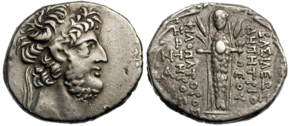Atargatis (deity)

Atargatis ( Greek ), Atar'ata ( Aramaic ), as Greco-Roman form Dea Syria ; was a Semitic deity, especially in the north of Syria , whose cult included ritual castration .
Strabo (XVI, 4,27) around the turn of times and Athenaios at the beginning of the 3rd century equated Aphrodite Urania of Ascalon with Atargatis. The goddess Derketo of Askalon and the Edessenian Taratha are also equated with Atargatis. Their most important temple was in Hierapolis Bambyke (today: Manbidsch ). Its symbol was the pomegranate , and it was sometimes associated with a fish.
According to Lucian of Samosata , their followers were tattooed , some on the wrist, others on the neck. This information is confirmed by a papyrus from Ptolemaic times, which describes a runaway slave from Hierapolis who had "barbaric letters" tattooed on his right wrist. Ulrich Wilcken suspects that these were the initials of Atargatis and the Aramaic high and weather god Hadad . Arameans worshiped Atargatis under the name 'Attar-'atteh.
The two are also depicted on a relief by Dura Europos that was found during the excavation of their temple: two figures sit next to each other, Atargatis is flanked by their lions. She is shown larger than Hadad sitting next to her, whose attribute, the ox, is pushed small to the left of the picture. The predominance of the main god takes a back seat to popular worship of his consort. Between the two figures is a post interpreted as a cult standard with three panes and a crescent moon above.
An inscription from Palmyra dated 132 AD designates the temple of the Atargatis there with 'tr' th. A Roman tessera shows the goddess with the head of an ox next to her and a star. In the Bel temple in Palmyra, Bel is depicted on the side of a massive limestone slab chasing a monster in his chariot. A group of six deities observes the scene, one of them is Atargatis, who can be recognized by their fish body.
literature
- Benjamin Hederich: Atargatis . In: Thorough mythological lexicon . Gleditsch, Leipzig 1770, Sp. 457-458 ( zeno.org ).
- Atargatis . In: Encyclopædia Britannica . 11th edition. tape 2 : Andros - Austria . London 1910, p. 823 (English, full text [ Wikisource ]).
- Ulrich Wilcken: To the 'Syrian Gods'. In: Festgabe for Adolf Deissmann on the occasion of his 60th birthday. Mohr, Tübingen 1927.
- Franz Joseph Dölger: Religious tattoo in the Atargati cult of Hierapolis in Syria. In: Antiquity and Christianity. Studies in the history of culture and religion. Volume 2, Aschendorff, Münster 1930, pp. 297-300.
- Wilhelm Vollmer: Atargatis or Atergatis . In: Dictionary of the mythology of all peoples . Revised by W. Binder. With an introduction to the mythological science of Johannes Minckwitz. Zentralantiquariat der DDR, Leipzig 1978, OCLC 616624415 , p. 78 ( vollmer-mythologie.de or zeno.org - photomechanical reprint of the original 1874 edition based on the copy from the Berlin University Library).
- Susanna Elm : “Pierced by Bronze Needles”: Anti-Montanist charges of ritual stigmatization in their fourth-century context. In: Journal of Early Christian Studies 4/4, 1996, pp. 409-439.
- Johanna Stuckey: Atargatis, the “Syrian Goddess”. In: MatriFocus Cross-Quarterly. Volume 8-3, 2009 ( matrifocus.com ).
Web links
- Derceto . In: Jewish Encyclopedia
Individual evidence
- ↑ matrifocus.com ( Memento of the original from February 27, 2015 in the Internet Archive ) Info: The archive link was inserted automatically and has not yet been checked. Please check the original and archive link according to the instructions and then remove this notice. Sketch of the relief.
- ↑ Javier Teixidor: The Pantheon of Palmyra. Études préliminaires aux religions orientales dans l'Émpire romain 79. Leiden 1979, pp. 71-76.